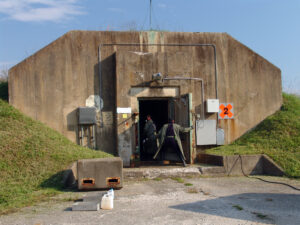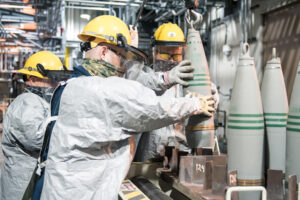The Chemical Stockpile Emergency Preparedness Program (CSEPP) was created in 1985 when the US Congress passed a law directing the Army to dispose of its aging chemical weapons inventory with maximum protection of the public and environment as its primary consideration.
Since its inception, the primary goal of CSEPP has been to educate and enhance emergency preparedness in communities surrounding the chemical stockpile stored at the Blue Grass Army Depot.

Ten counties in Kentucky are affected by the chemical stockpile. Madison County, where the Blue Grass Army Depot is located, and the northeast portion of Estill County are considered the Immediate Response Zones (IRZ). Areas in Clark, Estill, Fayette, Garrard, Jackson, Powel, and Rockcastle counties are included in the Protective Action Zone (PAZ). Jessamine and Laurel Counties are considered Host counties where citizens of the IRZ or PAZ may be deployed.
Until the chemical stockpile is safely destroyed, CSEPP will continue to support efforts to ensure a community’s preparedness and safety in the unlikely event of a chemical agent accident.
Blue Grass Army Depot
The Blue Grass Army Depot (BGAD) is located in the center of Madison County and covers approximately 15,000 acres, with 255 acres dedicated to chemical weapon storage and destruction. BGAD contains 852 igloos, of which 45 are dedicated to chemical weapons. Igloos are made of concrete, and are 80 feet long, 25 feet wide, and 15 feet high, with 2 feet of earth covering them. Some igloos contain munitions with chemical agents manufactured before 1968.

Before the start of neutralization, there were 8-inch projectiles, 155mm projectiles, and 115mm rockets (M55). Since 1944, the Army has safely stored approximately 2% of the nation’s original chemical weapons stockpile at BGAD. The installation is also used for the storage of conventional explosive munitions.
Prior to beginning the agent destruction process, BGAD stored 523.26 tons of chemical agent, which consisted of nerve (VX & GB) and blister (Mustard) agents.
The igloos contained:
276.68 tons of GB in M55 rockets**
28.83 tons of GB in 8-inch projectiles*
88.67 tons of VX in M55 rockets*
8.45 tons of VX in 155mm projectiles*
90.63 tons of Mustard or Agent H in 155mm projectiles*
Three 1-ton containers containing GB (destroyed during Operation Swift Solution)
Each munition contains between 6 to 14.5 pounds of agent.
* These munitions have been destroyed.
** These munitions are undergoing destruction.
Chemical Demilitarization

After Congress directed the Army to destroy its entire stockpile of chemical weapons, the Army’s original plan was to destroy the store at the Blue Grass Army Depot by constructing an incineration facility.
However, in response to public concerns regarding incineration, Congress mandated that the Army and Department of Defense evaluate the effectiveness of alternative destruction technologies. After a comprehensive evaluation process, the Department of Defense selected neutralization as the method of destruction.
The Bechtel Parsons Blue Grass Team was awarded a contract to design, construct, test, operate and close the Blue Grass Chemical Agent-Destruction Pilot Plant. During the neutralization process, munitions are disassembled using modified reverse assembly. After the agent and energetics are separated, the agent is chemically decomposed and neutralized by caustic or water hydrolysis.

The resulting chemical compound is known as “hydrolysate.”
The agent hydrolysate is stored on-site and will be transported to Texas at a commercial hazardous waste treatment, storage, and disposal facility.
Metal parts are thermally decontaminated. Gas effluents are recycled or filtered and monitored before being released into the atmosphere.
Static Detonation Chamber (SDC) units augment the Blue Grass Chemical Agent-Destruction Pilot Plant to destroy munitions that present a problem to process in the main plant. An SDC unit is destroying the mustard munitions stockpile after an X-ray assessment confirmed the solidification of the agent in a significant number of projectiles.
Additionally, the current SDC and a larger SDC unit will destroy drained rocket warheads and overpacked rockets. The SDC uses thermal destruction technology to eliminate weapons.
For the most up-to-date information on chemical weapons destruction, visit www.peoacwa.army.mil.